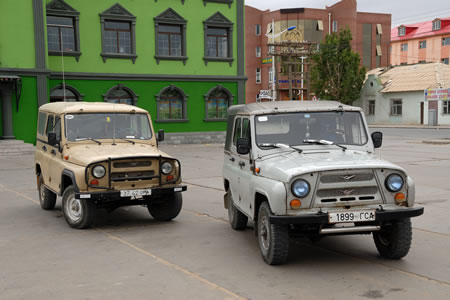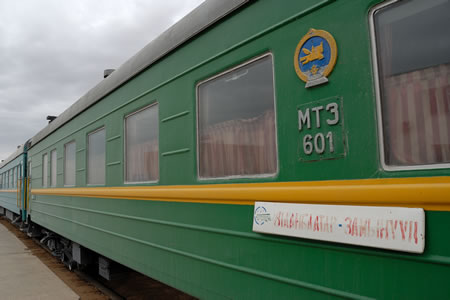English | Dutch |
|
| Spooning with a stranger | |
Ulaan Baatar (Mongolia), June 18th 2010 |
|
We reached the Chinese border town of Erlian after two days of sitting in a bus. Our final destination is the Mongolian capital of Ulaan Baatar, but we found the price for the direct train between Beijing and Ulaan Baatar way too much. That’s why we decided to travel this journey in more stretches. We first took the bus from Beijing to Hohhot, where we changed busses the following day for the trip to Erlian. Today we will cross the border to the Mongolian border town of Zamyn-Uud, where we plan to take the local train to Ulaan Baatar. Erlian is a midsized Chinese town on the grass steppes of the Chinese province Inner Mongolia. It is a typical border town. Most activities are related to the trade with Mongolia. And that is understandable, because we can’t really find another reason to build a city like this on the hot and dusty plains of the Gobi desert. We take a taxi early in the morning to the local jeep station, where Mongolian drivers and their Russian made jeeps are waiting for customers, to take them over the border. There is also an occasional bus to Zamyn-Uud, but most people prefer the jeep. The jeep is not only much faster; it is also possible to take a lot more luggage. And that is important for the Mongolian merchants who mainly take Chinese clothes to Mongolia to sell it on the local markets. |
|
 |
|
The Russian made jeeps that are used for the border crossing |
|
It doesn’t take long before we have enough passengers to set course for the Mongolian border. We stop just before the border to pick up a Mongolian family with an amount of luggage that we think never fits in the jeep. But after ten minutes of stuffing, all baggage is in the jeep. With ten people in the jeep, four on the front seats and six on the rear bench, we continue with the ride to the border. Fortunately, the journey isn’t that long. Ten minutes later, we arrive at the Chinese immigration office where the procedures are efficient. We get our exit stamp without any hassle and proceed with the jeep to the Mongolian immigration. Also here, the procedures are straightforward. We receive our entry stamp and after filling in the custom declaration form, we officially enter Mongolia. The Chinese characters have disappeared from the buildings and are replaced by the Cyrillic ones, also used in for example Russia. Outside the immigration office, on the parking spot, tens of jeeps are waiting for the one custom official who needs to check the baggage in the vehicles. Besides clothes, which are free of import taxes, the Mongolians also try to bring in other goods, like electronics, for which they have to pay an import fee. However, a solid check is not possible. Most of the packages are completely taped which makes a check almost impossible. Besides that, there are way too many pieces for one official. The custom official tries to check some of the packages, mainly by using one of her keys to make a small hole in the taped package, to see if there are also other items in it than just clothes. Also our jeep is ‘checked’. After making two small holes in two different packages, she let us go. Five minutes later, we arrive at the railway station of Zamyn-Uud. It is almost 11.30 am when one of the English speaking girls who shared the jeep with us, helps us buying the train tickets for the train of 05.30 pm to Ulaan Baatar. Unfortunately, the berths for the more comfortable soft sleeper class are sold out. That means that we have to do it with the more basic hard sleeper class. At around noon, the counter closes. All tickets for the train of today are sold out, which means that we are happy that we were able to get tickets anyway. While we are waiting for the train, we see that more and more people arrive at the platform with huge piles of baggage. Again, we are in doubt if that amount of baggage fits in the train. When the train arrives on the platform, chaos occurs. All the Mongolian merchants besiege the train, in the hope to find a place for their baggage. Most merchants hired porters to help them getting their stuff on the train. However, every door of the train is guarded by two tough train stewardesses who have the task to prevent people entering the train without a ticket. Some people try to find their way into the train illegally, but they are kicked out without any mercy. We also try to find our way to the door of the wagon, and because we have tickets, we are allowed to enter. The train is already quite full, but after some searching, we think we found our berths. However, we are not really sure because the numbering of the berths isn’t really straightforward. | |
 |
|
The local train from Zamyn-Uud to Ulaan Baatar |
|
| We take a seat on the two seats that a local merchant pointed out to us. Subsequently, we admire how the local merchants manage to get al their stuff on board. The wagon has almost 60 berths, divided in different open coupes with three berths above each other. However, the upper berths are only used for luggage, because it is for security reasons not allowed for people to sleep on it. Just after the train left the Zamyn-Uud station, the old lady next to Edwin asks him to leave his seat. She tells him that his seat is part of her berth and now she wants to take a nap. Edwin shows his tickets to prove that he also has a berth. After taking a look at it, the old lady tells him that we have bought tickets for the upper berths, you know, the berths that you can not sleep on. Edwin tells the lady that he is not planning to stand for 15 hours, so he stays on his seat. The lady is a little bit disappointed in the beginning, but shortly after, she gets involved in a card game with other merchants.
Around twelve at night, the old lady really wants to sleep. She swaps her berth with a young guy, who now takes place next to Edwin. Approximately an hour later, he also wants to sleep and suggests sharing a bed together. Edwin agrees and after transforming the seats and the table to a minuscule berth, Edwin and the guy share it together. For the first time in his life, he spooned with a stranger. |
|